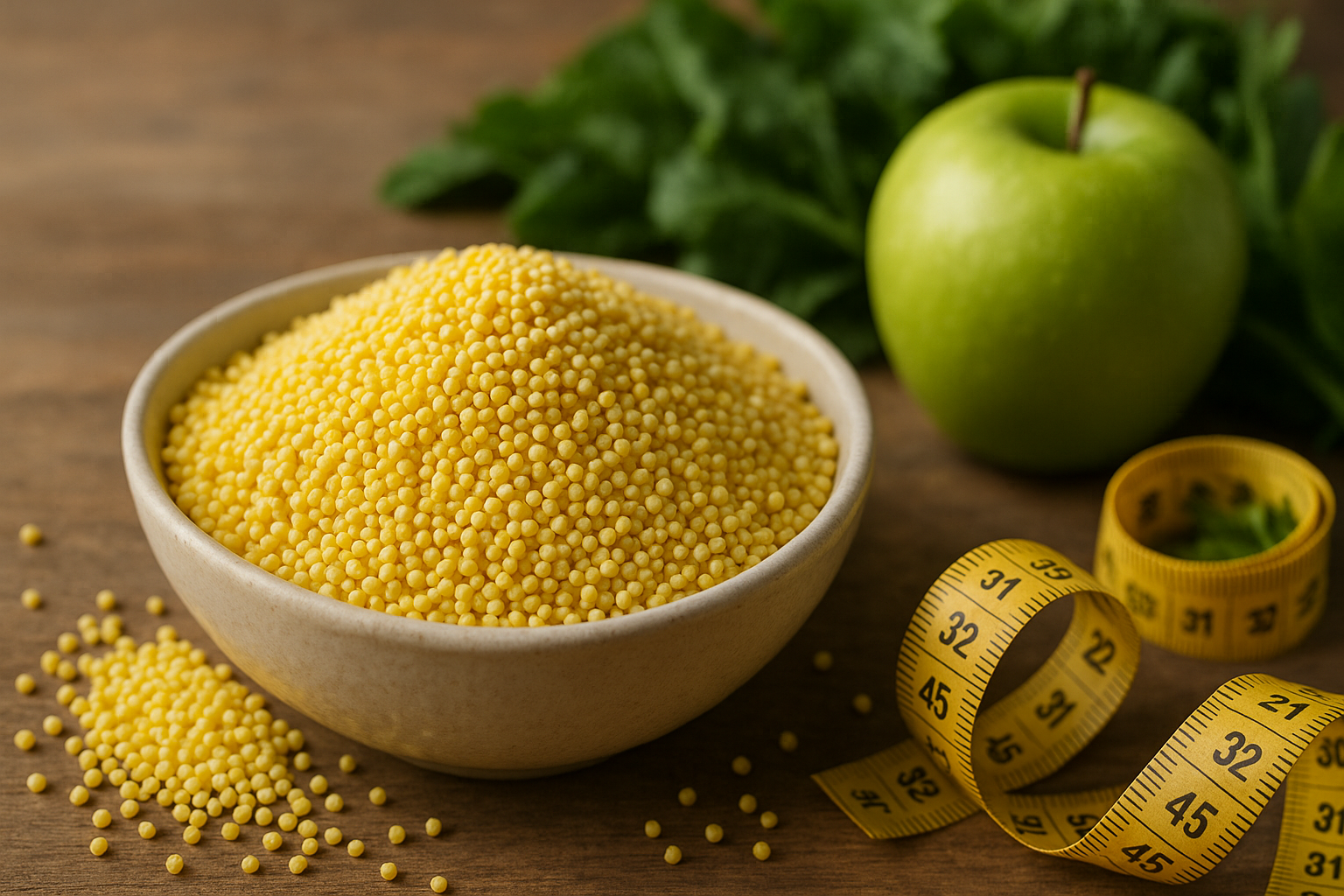Yellow millet is making a comeback in modern kitchens after years of taking a backseat to wheat and rice. These small golden grains pack a powerful nutritional punch that can help you achieve your weight management goals naturally. If you’re looking for a sustainable way to shed extra pounds while nourishing your body, yellow millet deserves a spot in your diet.
CMS Industries recognizes the growing demand for healthy, traditional grains like millet. As a trusted agricultural products manufacturer and exporter, we understand how ancient grains are transforming modern diets and supporting better health outcomes for people worldwide.
What is Yellow Millet?
Yellow millet refers to several varieties of small-seeded grains that typically display a golden or yellow appearance. The two most common types are foxtail millet (Setaria italica) and proso millet (Panicum miliaceum). Both have been cultivated for thousands of years across Asia, Africa, and Europe.
These grains were among the first cereals domesticated by humans, with foxtail and proso millet identified at 7,000-year-old Neolithic sites in North China. Their resilience in harsh climates and exceptional nutritional profile have made them staple foods in many cultures.
Foxtail millet features small yellow grains about 2-3 millimeters long, while proso millet grains are approximately 3 millimeters and can range from white to yellow or brown. Both varieties share similar health benefits and cooking properties.
Nutritional Profile of Yellow Millet
Understanding what makes yellow millet special starts with its nutrient composition. Protein content in millets ranges from 6 to 13%, with proso millet and foxtail millet being among the richest sources. Here is what you get from these grains:
Macronutrients:
- Complex carbohydrates for sustained energy
- Plant-based protein with essential amino acids
- Healthy fats including linoleic and oleic acids
- High dietary fiber content
Micronutrients:
- B vitamins (niacin, riboflavin, folate)
- Iron and calcium
- Magnesium and phosphorus
- Zinc and potassium
- Antioxidants including phenolic compounds
Millet proteins contain relatively high levels of essential amino acids such as lysine, methionine, and cysteine, which are limited in other cereal grains like rice and wheat. This makes yellow millet a more complete protein source compared to traditional grains.
How Yellow Millet Supports Weight Loss
High Fiber Content Promotes Satiety
One of the strongest advantages yellow millet offers for weight management is its impressive fiber content. The dietary fiber component in millet comprises 15-20% and contains non-starchy polysaccharides, arabinoxylan, and β-glucan.
Fiber works multiple ways to support weight loss. First, it slows digestion, keeping you fuller for longer periods. This natural appetite control helps reduce total calorie intake throughout the day. Second, fiber adds bulk to meals without adding calories, creating physical fullness in your stomach.
Soluble fiber in millets traps fat in your gut and can lower cholesterol levels in your blood, providing cardiovascular benefits alongside weight management support.
Low Glycemic Index Controls Blood Sugar
Yellow millet has a low glycemic index of approximately 50. This means millets release glucose slowly into the bloodstream, keeping you fuller for longer. When blood sugar remains stable, you avoid the energy crashes and cravings that often derail weight loss efforts.
High glycemic foods cause rapid blood sugar spikes followed by crashes that trigger hunger and overeating. The slow, steady energy release from yellow millet prevents this rollercoaster effect. Research on rats fed foxtail millet showed significantly lower triglycerides and C-reactive protein levels, suggesting benefits for preventing cardiovascular disease.
Protein Content Preserves Muscle Mass
Maintaining lean muscle during weight loss is important for keeping your metabolism active. Millets contain essential vitamins and minerals that support metabolism, energy production, and weight loss.
The plant-based protein in yellow millet helps preserve muscle tissue while your body burns fat. More muscle mass means higher resting metabolic rate, allowing you to burn more calories even at rest.
Supports Healthy Digestion
Good digestive health plays a role in weight management. The insoluble fiber in millets acts as a prebiotic, supporting good bacteria in your gut. A healthy gut microbiome has been linked to better weight regulation and reduced inflammation.
The fiber also promotes regular bowel movements, preventing bloating and discomfort that can make you feel heavier than you are. Better digestion means better nutrient absorption and more efficient metabolism.
Discover the Top 10 Yellow Millet Benefits for Female health and wellness — please read this blog!
Yellow Millet Benefits Beyond Weight Loss
Heart Health Protection
Your cardiovascular system benefits significantly from including yellow millet in your diet. Millets contain heart-healthy properties and magnesium, which may prevent heart failure. The soluble fiber helps reduce LDL cholesterol levels, while the antioxidants protect blood vessels from damage.
Blood Sugar Management
For people concerned about diabetes or prediabetes, yellow millet offers protective benefits. Studies show millet consumption lowers the incidence of blood sugar fluctuations and helps stabilize blood sugar levels in diabetics.
Research on diabetic rats fed foxtail millet showed a significant 70% fall in blood glucose, along with significantly lower levels of triglycerides and improved cholesterol profiles.
Gluten-Free Alternative
Yellow millet provides an excellent grain option for people with celiac disease or gluten sensitivity. Unlike wheat, barley, and rye, millet contains no gluten while still offering the satisfying texture and versatility of traditional grains.
Rich in Antioxidants
Millets are full of tannins, phytates, and phenols that help protect your cells against damage and potential diseases like high blood pressure, diabetes, and high cholesterol. These antioxidants fight free radicals that contribute to aging and chronic disease.
How to Include Yellow Millet in Your Diet
Cooking Yellow Millet
Preparing yellow millet is straightforward. Rinse the grains thoroughly under running water. Combine 1 cup of millet with 2 cups of water in a pot. Bring to a boil, then reduce heat and simmer covered for 15-20 minutes until the water is absorbed. Let it rest for 10 minutes before fluffing with a fork.
For enhanced flavor, toast the dry millet in your pot for a few minutes before adding water. This brings out a nutty taste that makes the grain more enjoyable.
Recipe Ideas for Weight Loss
Breakfast Options:
- Millet porridge with berries and nuts
- Savory millet upma with vegetables
- Millet pancakes using millet flour
Lunch and Dinner:
- Millet khichdi with lentils and spices
- Millet pilaf with mushrooms and herbs
- Stuffed bell peppers with millet filling
- Millet salad with fresh vegetables and lemon dressing
Snacks:
- Puffed millet as a crunchy snack
- Millet crackers or cookies (in moderation)
- Energy balls made with millet flour
Substitution Strategies
Replace rice or quinoa with cooked yellow millet in your favorite recipes. Use millet flour in baking to replace wheat flour partially or completely. Add cooked millet to soups and stews for extra nutrition and thickness.
CMS Industries supports farmers growing traditional grains like millet, helping ensure quality products reach consumers who want to make healthier dietary choices. Our commitment to sustainable agriculture means you can feel good about choosing millet products that support both your health and farming communities.
Tips for Successful Weight Loss with Yellow Millet
Watch Portion Sizes
While yellow millet offers many benefits, portion control remains important. Like all grains, millet contains carbohydrates and calories. Stick to serving sizes of about 1 cup cooked millet per meal. Remember that millet expands significantly when cooked, so measure carefully.
Combine with Other Healthy Foods
Yellow millet works best as part of a balanced diet. Pair it with:
- Lean proteins (chicken, fish, legumes, tofu)
- Plenty of vegetables for vitamins and fiber
- Healthy fats from nuts, seeds, and olive oil
- Fresh fruits for natural sweetness
Stay Consistent
Weight loss happens over time with consistent healthy choices. Aim to include yellow millet in your diet 4-5 times per week rather than daily. This frequency allows you to enjoy the benefits while maintaining dietary variety.
Prepare Millet in Healthy Ways
Cooking methods matter. Steam, boil, or lightly sauté millet rather than frying. Use minimal oil and focus on herbs and spices for flavor instead of heavy sauces or excessive salt. The natural nutty taste of yellow millet shines through with simple preparations.
Potential Considerations
Digestive Adjustment Period
If you’re new to eating millet, start with small portions. The high fiber content can cause temporary bloating or gas as your digestive system adjusts. Gradually increase your intake over several weeks to allow your gut bacteria to adapt.
Antinutrients in Millet
Millet bran contains phytate and other compounds that can interfere with mineral absorption. Soaking millet for several hours before cooking helps reduce these antinutrients and improves nutrient availability.
Balance is Important
While yellow millet offers many benefits, eating it exclusively is not recommended. Vary your whole grain intake to include other nutritious options and ensure you get a full spectrum of nutrients. Some nutritionists suggest limiting millet consumption to prevent potential thyroid concerns with excessive intake.
Get informed with the 8 key specifications every buyer should know about yellow millet — please read this blog!
Comparing Yellow Millet to Other Weight Loss Grains
Yellow Millet vs. Brown Rice
Millets have higher protein and fat content, along with lower carbohydrate content compared to brown rice. The fiber content in millet also exceeds that of brown rice, making it potentially more satisfying for weight management.
Yellow Millet vs. Quinoa
Both are gluten-free and protein-rich. Quinoa contains all nine essential amino acids, making it a complete protein. Yellow millet offers more iron and certain B vitamins. Both work well for weight loss, so choose based on taste preference and availability.
Yellow Millet vs. Wheat
Yellow millet is gluten-free while wheat contains gluten. Millet has a lower glycemic index than refined wheat products. For weight loss, millet offers better blood sugar control and sustained energy compared to white bread or white pasta.
Making Yellow Millet Work for Your Lifestyle
Meal Prep Strategies
Cook a large batch of yellow millet at the start of your week. Store it in the refrigerator for up to 5 days. Use it throughout the week in different dishes to save time and ensure you always have a healthy grain option ready.
Family-Friendly Approaches
Getting family members on board with dietary changes can be challenging. Introduce yellow millet gradually by mixing it with familiar grains like rice at first. Try millet in dishes your family already enjoys, such as replacing rice in stuffed vegetables or adding it to meatballs.
Budget-Conscious Shopping
Yellow millet typically costs less than trendy grains like quinoa. CMS Industries and other agricultural suppliers work to make traditional grains accessible and affordable. Buy in bulk from trusted suppliers to save money while supporting sustainable agriculture.
Restaurant and Travel Tips
When eating out, look for restaurants serving ethnic cuisines that traditionally use millet. African, Indian, and Asian restaurants often feature millet-based dishes. When traveling, pack puffed millet as a portable snack that provides nutrition without requiring preparation.
The Science Behind Millet and Metabolism
Millets are rich in B vitamins like niacin, riboflavin, and folate, which support metabolism and energy production. A higher metabolic rate means you burn more calories throughout the day, even during rest periods.
Studies on millet protein concentrate showed it significantly increased plasma adiponectin and HDL cholesterol while reducing insulin levels compared to casein diets. Adiponectin is a hormone that helps regulate metabolism and blood sugar, playing a role in how your body burns fat.
The complex carbohydrates in yellow millet digest slowly, requiring more energy for breakdown. This thermic effect of food means your body expends calories simply processing what you eat. While this effect is modest, it contributes to overall calorie balance over time.
Creating a Sustainable Approach
Weight loss is not just about short-term changes. Yellow millet fits perfectly into a sustainable, long-term healthy eating pattern. Unlike restrictive diets that eliminate entire food groups, incorporating yellow millet means adding nutritious variety to your meals.
The environmental sustainability of millet cultivation also matters. These grains require less water than rice and grow well in challenging climates. By choosing yellow millet, you support agricultural practices that protect our planet while nourishing your body.
Conclusion
Yellow millet offers a time-tested, nutritionally dense option for people seeking natural weight loss support. Its combination of high fiber, plant-based protein, low glycemic index, and essential nutrients makes it an excellent addition to a balanced diet. The grain’s versatility in cooking means you can enjoy it in countless ways without getting bored.
Starting your journey with yellow millet is simple. Visit CMS Industries to learn more about sourcing quality agricultural products, including traditional grains like millet that support your health goals. Our commitment to connecting farmers with consumers ensures you get authentic, nutrient-rich grains that deliver real results.
Remember that sustainable weight loss comes from consistent healthy choices over time. Yellow millet can be one part of your strategy, alongside regular physical activity, adequate sleep, stress management, and a varied whole-foods diet. Give these golden grains a try and experience how ancient wisdom meets modern nutrition science for better health and lasting weight management.
Frequently Asked Questions
What makes yellow millet different from other types of millet for weight loss?
Yellow millet, particularly foxtail and proso varieties, contains specific amino acids like tryptophan that help reduce hunger and support fat metabolism. The golden varieties tend to have slightly higher protein content and a pleasant nutty flavor that makes them easier to incorporate into various dishes. All millet types support weight loss through high fiber and low glycemic index, but yellow varieties offer excellent versatility in cooking.
How much yellow millet should I eat daily to support weight loss?
Aim for one to two servings of cooked yellow millet per day, with each serving being about one cup. This amount provides beneficial fiber and nutrients without excessive calories. Eating millet 4-5 times weekly rather than every day helps maintain dietary variety and prevents potential issues from overconsumption. Remember to balance millet with plenty of vegetables, lean proteins, and healthy fats for best results.
Can yellow millet help me lose belly fat specifically?
Yellow millet cannot target belly fat specifically, as spot reduction is not possible. The grain does support overall fat loss through its high fiber content, low glycemic index, and ability to promote satiety. The stable blood sugar levels it provides help prevent insulin spikes that can lead to abdominal fat storage. Combined with regular exercise and a calorie-controlled diet, yellow millet contributes to total body fat reduction including the belly area.
Is yellow millet better than rice or wheat for weight management?
Yellow millet offers several advantages over rice and wheat for weight loss. It has a lower glycemic index than white rice, more fiber than both rice and wheat, and higher protein content than white rice. Millet is also gluten-free, making it suitable for more people. The slower digestion of millet keeps you satisfied longer than refined wheat products, reducing the likelihood of overeating between meals.
Are there any side effects of eating yellow millet daily for weight loss?
Most people tolerate yellow millet well, but some may experience digestive changes when first introducing high-fiber foods. Start with small portions and gradually increase to allow your system to adjust. Consuming excessive amounts daily may potentially interfere with thyroid function, which is why nutrition experts recommend eating millet 4-5 times weekly rather than at every meal. Soaking millet before cooking reduces antinutrients and improves digestibility for most people.





